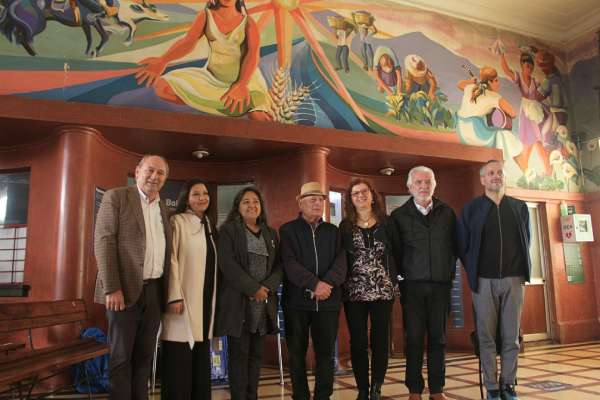On more than one occasion, the artist and teacher Alicia Valenzuela made known her wish for the Mural “Ñuble, Luz, Greda y Canto” at the Chillán Railway Station to be restored.
She always did it, even in a pandemic, when despite the restrictions she traveled from Santiago to Chillán to visit the painting that she created with her hands 30 years ago, helped by students from the University of Bío Bío.
Capturing the essence of this area to introduce visitors to the countryside, traditions and pottery were her objectives and today, finally, the artist can say that she sees her dream fulfilled.
This year, the Ministry of Cultures, Arts and Heritage approved a project presented by the La Favorecedora Group. Katterina Osorio Campanella is in charge of the project, which was awarded 25 million pesos for the work. Katterina is, like Alicia was, a professor at the University of Bío-Bío and also has a degree in Arts, a diploma in Conservation and Restoration of Historical-Artistic Heritage and a doctoral candidate in the same program at the Complutense University of Madrid. She came to the project when Alicia and her daughter Arlette started asking who could take on this responsibility. Thanks to an architect friend, they came to Katterina, who already has experience advising on several works of the same type, among them, the restoration of the Historia de Concepción mural, made by Gregorio de la Fuente in the Municipality of Bío Bío.
The restoration work on the mural began this Thursday and although Alicia could not be present at the beginning of this challenge that will last three months, her daughter, Carla Ibarra Valenzuela, who is also part of the board of directors of the Association of Painters and Sculptors, was. From Chile.
At the ceremony in which the work began, Carla recalled that she was also part of the creation of the mural. “I was painting the mural in 1993. I traveled intermittently, I think about five or six times, to paint some sections of the mural and well, now I have a lot of emotions, a lot of history about this work that collects the cultural heritage of the Ñuble area. I am also happy to be part of the restoration, let’s say, accompanying this entire process and, well, I hope that everything goes well and that we have the mural shining again, just as it was left 30 years ago,” highlighted the artist.
History
Alicia Valenzuela began painting the mural in 1992 and finished it in 1993. The composition and general content of this mural is inspired by popular arts and other folkloric motifs that have given special character to the Ñuble Region.
The mural begins on the west wall, with the most traditional figures of Quinchamalí ceramics and a ceramic pot. Meanwhile, to the east, there is the primitive loom weaving of Minas del Prado, the basketry and wicker weaving of Roblería, which together with the wood carving of Coihueco, exalt the values of the artistic, manual, and popular tradition. and anonymous.
On the north wall is the central motif, a woman with her hair adorned with Copihues and the sun projecting its stylized rays. The Chilean rodeo, the grape harvest, the cultivation of the land, the cueca, the spinning and the mate acquire life and presence in a total of twenty human figures, along with other angular elements.
Alicia painted it with the help of students from the same Bío-Bío University where she taught classes. Alicia Valenzuela herself told details of the work in an audiovisual work that aimed to document the work carried out in the nineties. “You see the richness of the land. There is a huaso who is greeting the arriving passengers. We started working on December 15, 1992, four students. We even worked on Saturdays and Sundays, it was quite hard work. Nor is it a job where one is satisfied at a certain moment, it is permanent creation, because painting human figures is complex and we need many models.”
“We wanted to highlight what is ours, our folkloric roots, the value that Quinchamalí has, the country house, the customs like the rodeo and everything that means being in the center of Chile. Also the Chilean woman with that red copihue in her hair. There is also the richness of the land in their farming area,” she said.
The story goes that they worked eight hours a day including Saturdays and Sundays.
In three more months the work would be completed if everything goes well. This mural adds to the news of the recovery of the work of Julio Escámez in the Municipality of Chillán, city of murals.


